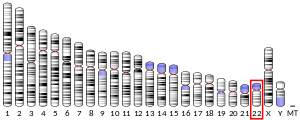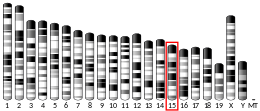PLA2G6
85 kDa calcium-independent phospholipase A2, also known as 85/88 kDa calcium-independent phospholipase A2, Group VI phospholipase A2, Intracellular membrane-associated calcium-independent phospholipase A2 beta, or Patatin-like phospholipase domain-containing protein 9 is an enzyme that in humans is encoded by the PLA2G6 gene.[5][6][7][8][9][10]
Structure
[edit]The PLA2G6 gene is located on the p arm of chromosome 22 at position 13.1 and it spans 80,605 base pairs.[8] The PLA2G6 gene produces an 18.6 kDa protein composed of 166 amino acids.[11][12] The resulting protein's structure has been shown to contain a lipase motif and 8 ankyrin repeats.[5] Different from rodent PLA2G6, which is known to share 90% overall amino acid sequence identity with that of the humans, the human PLA2G6 protein contains a 54-residue insertion which codes for a proline-rich region. This insertion has been shown to disrupt the last putative ankyrin repeat, as well as function as a linker region that segregates the N-terminal protein-binding domain from the C-terminal catalytic domain.[5][13]
Function
[edit]The PLA2G6 gene encodes for a phospholipase A2 enzyme, which is a subclass of enzyme that catalyzes the release of fatty acids from phospholipids.[8] This type of enzyme is responsible for breaking down (metabolizing) phospholipids. Phospholipid metabolism is essential for many body processes, including helping to maintain the integrity of the cell membrane.
Specifically, the A2 phospholipase produced from the PLA2G6 gene, sometimes called PLA2 group VI, helps to regulate the levels of a compound called phosphatidylcholine, which is abundant in the cell membrane.[14] The encoded protein may also play a role in phospholipid remodelling, arachidonic acid release, nitric oxide-induced or vasopressin-induced arachidonic acid release and in leukotriene and prostaglandin synthesis, Fas receptor-mediated apoptosis, and transmembrane ion flux in glucose-stimulated B-cells.[8][9]
It addition, it has a role in cardiolipin (CL) deacylation, and is required for both speed and directionality of monocyte MCP1/CCL2-induced chemotaxis through regulation of F-actin polymerization at the pseudopods. Isoform ankyrin-iPLA2-1 and isoform ankyrin-iPLA2-2, which lack the catalytic domain, are probably involved in the negative regulation of PLA2G6 activity.[9] Several transcript variants encoding multiple isoforms have been described, but the full-length nature of only two of them have been determined to date.[8]
Catalytic activity
[edit]Phosphatidylcholine + H2O = 1-acylglycerophosphocholine + a carboxylate.[10][9]
Clinical significance
[edit]Mutations in PLA2G6 has been shown to result in mitochondrial deficiencies and associated disorders, including PLA2G6-associated neurodegeneration (PLAN), which has several subtypes and is also known as Neurodegeneration with brain iron accumulation type 2 (NBIA2), other forms of disease are also referred to as Parkinson disease 14 (PARK14), and hereditary spastic paraplegia.[15][9][10]
PLA2G6-associated neurodegeneration (PLAN)
[edit]PLA2G6-associated neurodegeneration (PLAN) is a neurodegenerative disorder associated with iron accumulation in the brain, primarily in the basal ganglia. It is characterized by progressive extrapyramidal dysfunction leading to rigidity, dystonia, dysarthria and sensorimotor impairment.[9][10][16]
Infantile neuroaxonal dystrophy (INAD)
[edit]The most severe form is called infantile neuroaxonal dystrophy (INAD), also Neurodegeneration with brain iron accumulation type 2A (NBIA2A), and is characterized by pathologic axonal swelling and spheroid bodies in the central nervous system. Onset is within the first 2 years of life with death often by the age of 10 years.[9][10][16]
Atypical neuroaxonal dystrophy (atypical NAD)
[edit]A later-childhood onset and more slowly progressive form is called atypical neuraxonal dystrophy (atypical NAD), also Neurodegeneration with brain iron accumulation type 2B (NBIA2B).[16]
PLA2G6-related dystonia-parkinsonism
[edit]An adult-onset disease called PLA2G6-related dystonia-parkinsonism develop dystonia and parkinsonism after earlier normal development, and is also caused by biallelic mutations to PLA2G6.[16]
Parkinson disease 14 (PARK14)
[edit]Parkinson disease 14 (PARK14) is an adult-onset progressive neurodegenerative disorder characterized by parkinsonism, dystonia, severe cognitive decline, cerebral and cerebellar atrophy and absent iron in the basal ganglia on magnetic resonance imaging.[9][10]
Hereditary spastic paraplegia
[edit]Hereditary spastic paraplegias are a diverse class of hereditary degenerative spinal cord disorders characterized by a slow, gradual, progressive weakness and spasticity (stiffness) of the legs. Initial symptoms may include difficulty with balance, weakness and stiffness in the legs, muscle spasms, and dragging the toes when walking. In some forms of the disorder, bladder symptoms (such as incontinence) may appear, or the weakness and stiffness may spread to other parts of the body. Rate of progression and the severity of symptoms are quite variable.[17]
Another disease associated with mutations in this gene is infantile neuroaxonal dystrophy.
Interactions
[edit]PLA2G6 has been shown to have Protein-protein interactions with the following.[18][9]
References
[edit]- ^ a b c GRCh38: Ensembl release 89: ENSG00000184381 – Ensembl, May 2017
- ^ a b c GRCm38: Ensembl release 89: ENSMUSG00000042632 – Ensembl, May 2017
- ^ "Human PubMed Reference:". National Center for Biotechnology Information, U.S. National Library of Medicine.
- ^ "Mouse PubMed Reference:". National Center for Biotechnology Information, U.S. National Library of Medicine.
- ^ a b c Larsson PK, Claesson HE, Kennedy BP (January 1998). "Multiple splice variants of the human calcium-independent phospholipase A2 and their effect on enzyme activity". The Journal of Biological Chemistry. 273 (1): 207–214. doi:10.1074/jbc.273.1.207. PMID 9417066.
- ^ Wilson PA, Gardner SD, Lambie NM, Commans SA, Crowther DJ (September 2006). "Characterization of the human patatin-like phospholipase family". Journal of Lipid Research. 47 (9): 1940–1949. doi:10.1194/jlr.M600185-JLR200. PMID 16799181.
- ^ Kienesberger PC, Oberer M, Lass A, Zechner R (April 2009). "Mammalian patatin domain containing proteins: a family with diverse lipolytic activities involved in multiple biological functions". Journal of Lipid Research. 50 Suppl (Suppl): S63 – S68. doi:10.1194/jlr.R800082-JLR200. PMC 2674697. PMID 19029121.
- ^ a b c d e "Entrez Gene: PLA2G6 phospholipase A2, group VI (cytosolic, calcium-independent)".
 This article incorporates text from this source, which is in the public domain.
This article incorporates text from this source, which is in the public domain.
- ^ a b c d e f g h i "PLA2G6 - 85/88 kDa calcium-independent phospholipase A2 - Homo sapiens (Human) - PLA2G6 gene & protein". Retrieved 2018-08-22.
 This article incorporates text available under the CC BY 4.0 license.
This article incorporates text available under the CC BY 4.0 license.
- ^ a b c d e f "UniProt: the universal protein knowledgebase". Nucleic Acids Research. 45 (D1): D158 – D169. January 2017. doi:10.1093/nar/gkw1099. PMC 5210571. PMID 27899622.
- ^ Zong NC, Li H, Li H, Lam MP, Jimenez RC, Kim CS, et al. (October 2013). "Integration of cardiac proteome biology and medicine by a specialized knowledgebase". Circulation Research. 113 (9): 1043–1053. doi:10.1161/CIRCRESAHA.113.301151. PMC 4076475. PMID 23965338.
- ^ "85/88 kDa calcium-independent phospholipase A2". Cardiac Organellar Protein Atlas Knowledgebase (COPaKB). Archived from the original on 2018-08-23. Retrieved 2018-08-23.
- ^ Ma Z, Wang X, Nowatzke W, Ramanadham S, Turk J (April 1999). "Human pancreatic islets express mRNA species encoding two distinct catalytically active isoforms of group VI phospholipase A2 (iPLA2) that arise from an exon-skipping mechanism of alternative splicing of the transcript from the iPLA2 gene on chromosome 22q13.1". The Journal of Biological Chemistry. 274 (14): 9607–9616. doi:10.1074/jbc.274.14.9607. PMC 3715997. PMID 10092647.
- ^ "PLA2G6". Genetics Home Reference. NCBI.
 This article incorporates text from this source, which is in the public domain.
This article incorporates text from this source, which is in the public domain.
- ^ Ozes B, Karagoz N, Schüle R, Rebelo A, Sobrido MJ, Harmuth F, et al. (November 2017). "PLA2G6 mutations associated with a continuous clinical spectrum from neuroaxonal dystrophy to hereditary spastic paraplegia". Clinical Genetics. 92 (5): 534–539. doi:10.1111/cge.13008. PMC 5597457. PMID 28295203.
- ^ a b c d Gregory A, Kurian MA, Maher ER, Hogarth P, Hayflick SJ (1993). "PLA2G6-Associated Neurodegeneration". GeneReviews. University of Washington, Seattle. PMID 20301718. Retrieved 21 April 2022.
- ^ "Hereditary spastic paraplegia". www.uniprot.org.
- ^ Mick DU, Dennerlein S, Wiese H, Reinhold R, Pacheu-Grau D, Lorenzi I, et al. (December 2012). "MITRAC links mitochondrial protein translocation to respiratory-chain assembly and translational regulation". Cell. 151 (7): 1528–1541. doi:10.1016/j.cell.2012.11.053. hdl:11858/00-001M-0000-000E-DDDF-4. PMID 23260140.
Further reading
[edit]- Schröder HC, Perovic S, Kavsan V, Ushijima H, Müller WE (1998). "Mechanisms of prionSc- and HIV-1 gp120 induced neuronal cell death". Neurotoxicology. 19 (4–5): 683–688. PMID 9745929.
- Leslie CC (February 2004). "Regulation of arachidonic acid availability for eicosanoid production". Biochemistry and Cell Biology. 82 (1): 1–17. doi:10.1139/o03-080. PMID 15052324.
- Turk J, Ramanadham S (October 2004). "The expression and function of a group VIA calcium-independent phospholipase A2 (iPLA2beta) in beta-cells". Canadian Journal of Physiology and Pharmacology. 82 (10): 824–832. doi:10.1139/y04-064. PMID 15573142.
- Law MH, Cotton RG, Berger GE (June 2006). "The role of phospholipases A2 in schizophrenia". Molecular Psychiatry. 11 (6): 547–556. doi:10.1038/sj.mp.4001819. PMID 16585943.
- Tang J, Kriz RW, Wolfman N, Shaffer M, Seehra J, Jones SS (March 1997). "A novel cytosolic calcium-independent phospholipase A2 contains eight ankyrin motifs". The Journal of Biological Chemistry. 272 (13): 8567–8575. doi:10.1074/jbc.272.13.8567. PMID 9079687.
- Mavoungou E, Georges-Courbot MC, Poaty-Mavoungou V, Nguyen HT, Yaba P, Delicat A, et al. (September 1997). "HIV and SIV envelope glycoproteins induce phospholipase A2 activation in human and macaque lymphocytes". Journal of Acquired Immune Deficiency Syndromes and Human Retrovirology. 16 (1): 1–9. doi:10.1097/00042560-199709010-00001. PMID 9377118.
- Larsson Forsell PK, Kennedy BP, Claesson HE (June 1999). "The human calcium-independent phospholipase A2 gene multiple enzymes with distinct properties from a single gene". European Journal of Biochemistry. 262 (2): 575–585. doi:10.1046/j.1432-1327.1999.00418.x. PMID 10336645.
- Dunham I, Shimizu N, Roe BA, Chissoe S, Hunt AR, Collins JE, et al. (December 1999). "The DNA sequence of human chromosome 22". Nature. 402 (6761): 489–495. Bibcode:1999Natur.402..489D. doi:10.1038/990031. PMID 10591208.
- Kim SJ, Gershov D, Ma X, Brot N, Elkon KB (September 2002). "I-PLA(2) activation during apoptosis promotes the exposure of membrane lysophosphatidylcholine leading to binding by natural immunoglobulin M antibodies and complement activation". The Journal of Experimental Medicine. 196 (5): 655–665. doi:10.1084/jem.20020542. PMC 2194002. PMID 12208880.
- Hichami A, Joshi B, Simonin AM, Khan NA (November 2002). "Role of three isoforms of phospholipase A2 in capacitative calcium influx in human T-cells". European Journal of Biochemistry. 269 (22): 5557–5563. doi:10.1046/j.1432-1033.2002.03261.x. PMID 12423354.
- Cummings BS, McHowat J, Schnellmann RG (March 2004). "Role of an endoplasmic reticulum Ca2+-independent phospholipase A2 in cisplatin-induced renal cell apoptosis". The Journal of Pharmacology and Experimental Therapeutics. 308 (3): 921–928. doi:10.1124/jpet.103.060541. PMID 14634037. S2CID 1036850.
- Bao S, Jin C, Zhang S, Turk J, Ma Z, Ramanadham S (February 2004). "Beta-cell calcium-independent group VIA phospholipase A(2) (iPLA(2)beta): tracking iPLA(2)beta movements in response to stimulation with insulin secretagogues in INS-1 cells". Diabetes. 53 (90001, Suppl 1): S186 – S189. doi:10.2337/diabetes.53.2007.S186. PMC 3761941. PMID 14749286.
- Tanaka H, Minakami R, Kanaya H, Sumimoto H (August 2004). "Catalytic residues of group VIB calcium-independent phospholipase A2 (iPLA2gamma)". Biochemical and Biophysical Research Communications. 320 (4): 1284–1290. doi:10.1016/j.bbrc.2004.05.225. PMID 15249229.







